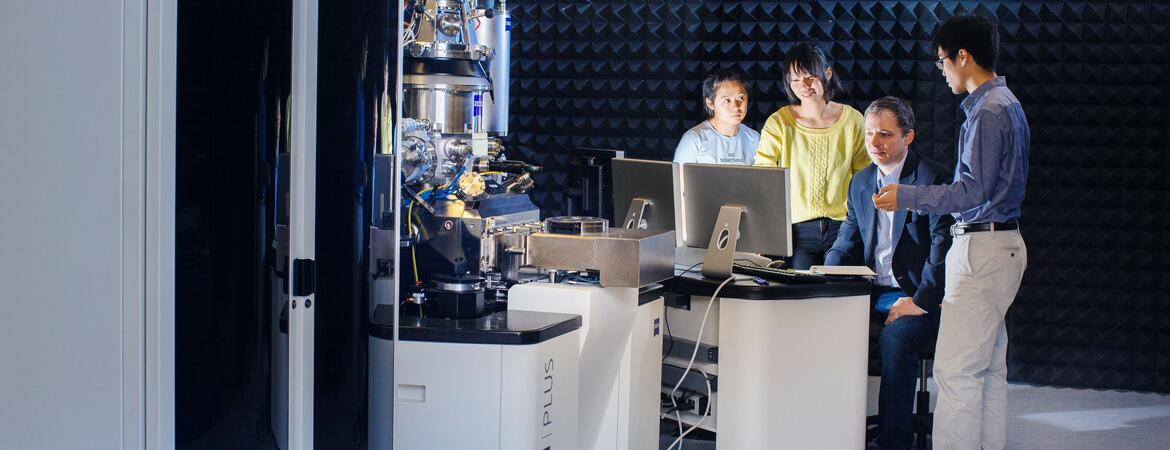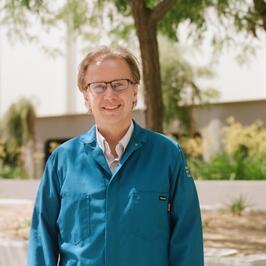
Scientists at UC Riverside and UC Irvine have received funding of $5 million from the U.S. Department of Energy, or DOE, to team up with Sandia National Laboratory in Albuquerque, New Mexico, in building a diverse educational pipeline in the field of microelectronics — a priority for industry and government. Of this amount, nearly $4 million is allocated to UC Riverside.
“There is a critical need for a strong domestic semiconductor industry and infrastructure — and for graduate research projects that offer students from all backgrounds the requisite skills to work in that industry,” said Shane Cybart, an associate professor of electrical and computer engineering and the principal investigator of the five-year grant. “We have an urgent need to develop human resources with advanced skill sets in microelectronics and related materials engineering.”
Semiconductors, used in almost every sector of electronics, play an important role in everyday life. Mobile phones, digital cameras, televisions, laptops, games consoles, microwaves, refrigerators, washing machines, and LED bulbs all use semiconductor components. According to the Semiconductor Industry Association, the U.S. share of the global semiconductor manufacturing capacity, which was 37% back in 1990, has dropped to 12%.
The grant originates from the National Nuclear Security Administration, or NNSA, a part of the DOE, and seeks to educate and recruit the next generation of civilian individuals able to detect counterfeit electronics.
Cybart explained that, historically, the United States dominated the semiconductor industry. Over the years, however, most of the semiconductor manufacturing moved to Asia.
“Loss of a robust domestic semiconductor industry poses a serious threat to national security, from chip shortages and counterfeits to embedded hidden malicious hardware,” he said. “To revitalize the U.S. chip industry, we will need a well-trained domestic workforce in microelectronics-related fields. Our project, called MEMENCYS, combines research in chip editing, fabrication of novel device materials and structures, and investigation of radiation effects on microelectronics.”
Cybart, who directs the UCR Nanofabrication Facility, is joined by Ludwig Bartels, a professor of chemistry at UCR; Xiaoqing Pan, a professor of physics and materials science at UCI; and Ed Bielejec, director of the Ion Beam Laboratory at Sandia National laboratory.
A summer undergraduate research program will take place at UCR each year of the project using infrastructure established in a current National Science Foundation-funded Research Experience for Undergraduate Students site: MacREU. Undergraduate students will get to team up with graduate mentors and be assigned projects that contribute to the research objectives of the partnership. Some students may join mentors at Sandia National Laboratory. At the graduate level, a total of six doctoral students will conduct dissertation work and travel to Sandia National Laboratory to work with lab staff. One postdoctoral researcher will work on the project.
Participation of Hispanic students in the project is emphasized. The grant originates from the NNSA’s Minority Serving Institution Partnership Program, recognizing that the project depends on the contribution of individuals from all backgrounds. UCR is a certified Hispanic-Serving Institution, with an enrollment of almost 40% Hispanic students. Enrollment in MacREU is almost 50% Hispanic.
The project will train students in cybersecurity, hardware forensics, and radiation effects. They will investigate unanswered questions related to electronic materials and quantum devices and develop hands-on expertise with focused ion beams, electron microscopes, and materials synthesis.
“Traditionally, we have seen low Hispanic participation in the STEM workforce,” said Ludwig Bartels, the grant’s co-principal investigator and director of the MacREU at UCR. “Increasing enrollment in STEM degrees, which are often perceived as harder and needing more time commitment, requires financial support and direct year-round mentorship. Such support programs, once established, are not limited to Hispanic students, ultimately benefiting any student socioeconomically challenged in pursuing a STEM degree.”
Cybart, who has decades of experience in nanofabrication, electrical characterization, and superconducting devices, will oversee research in gas field ion source nanofabrication and superconductor electronics. Bartels, who has collaborated with researchers at the Sandia National Laboratory for more than 10 years, will lead research efforts in irradiation effects on materials as well as direct the undergraduate program at UCR. Pan will help graduate students develop innovative transmission electron microscopy techniques for electrical circuits, characterization of materials, and atomic level imaging of radiation defects. Bielejec will connect UCR and UCI students with the appropriate research groups and technical staff at Sandia National Laboratory.
“Our scientific objectives are directly geared toward training graduate students in skills and fields of imminent need for the National Nuclear Security Administration, and to help place them in NNSA labs as postdoctoral scholars after graduation,” Cybart said. “Our prior records in advising, mentoring, and graduating diverse domestic students point to a very high likelihood of success.”
Cybart and Bartels are faculty members in UCR’s Materials Science and Engineering program.
Header image credit: Elena Zhukova.





